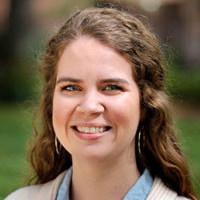

Liz McQuain recommends practices and develops trainings that will increase the diversity of participants to better represent communities in participatory science efforts, as well as increase uniform platforms for sharing and analyzing water resources data. McQuain looks forward to making national, regional and local impacts on the future of participatory science efforts.
Find updates from Sea Grant’s Participatory Science Liaison, Liz McQuain, below.
April 2024
Participatory science—why the change in terminology
Some may think that all the terms referring to public participation in the scientific process could be thrown in a hat and whichever is pulled out will work. They are all just different terms that mean relatively the same thing, right? Well, it is not that simple. Terminology has power and words have meaning. Words, phrases, and titles provide identity: a set of characteristics that one may assume based on the historical and current context. When choosing a term to encompass all of Sea Grant’s programming that includes public participation in the scientific process, it was important to understand the power and meaning attached to each.
So the big question: What do you call a program that engages interested parties in the scientific process? The answer: Well… it depends. Traditionally, the most used and widely recognized term was ‘citizen science’. However, the use of this term has evolved over time to be perceived as exclusionary. Straying from the original intent of the inclusion of the members of the public in an aspect of scientific research (Eitzel, et al., 2017), in the U.S. it can be seen as requiring citizenship to participate or a ‘take the data and run’ mentality. The term ‘citizen science’ is closely tied with a traditional top-down engagement method, where those in charge of the project come to a community to have participants help collect large quantities of data (Bonney, et al., 2009). Even though the collected data helped to advance scientific knowledge, oftentimes the participants were not involved in how the data were used. The historical exploitation of participants as data collectors has caused many programs to divert from the term ‘citizen science’.
Another common term used to describe programs where the public participates in the scientific process is ‘community science’. ‘Community science’ is rooted in the community, as the name suggests and is more associated with a bottom-up engagement approach. Starting in the Environmental Justice movement, community science has been happening since about the 1980s and 1990s, but has only recently, in the 2010s, started to be adopted by other organizations to better reflect their work and strive toward inclusivity. These programs are focused on the goals and needs of community members as well as actionable solutions, and are often led by community members (Charles, et al., 2020).
While ‘citizen science’ and ‘community science’ are what Sea Grant has used to coin our efforts as of late, that isn’t to say that there are other terms out there being used. Volunteer monitoring, crowdsourcing, collaborative research and co-production of knowledge are other terms used to describe public participation in the scientific process, however these are a little more prescriptive and less general (Satterthwaite, et al., 2024; Table 1).
So, you may be wondering, what is Sea Grant using now? What term best encompasses what Sea Grant does in their wide range of programs and projects and their unique place-based organizational structure? Participatory Science. ‘Participatory science’ serves as an umbrella term to include multiple methods of engaging with participants in the scientific process to achieve common goals and address shared issues. Notably, the Environmental Protect Agency has made the terminology change from ‘citizen science’ to ‘participatory science’, as well as the Association for Advancing Participatory Sciences, formerly the Citizen Science Association. Other agencies and organizations are also making the move to participatory science as it encompasses more than a single way of engagement and outcomes from public-engaged science.
The Sea Grant Network utilizes its assets that include strong linkages with communities and university researchers, technical expertise, cross-network communication platforms and excellence in science outreach as a way of including the public in the scientific process. Participants collect data, collaborate on project design and/or analyze results around a topic of interest—water quality, weather, public health, astronomy, etc.—and through their collective action provide new insights, data sources, discoveries and perspectives that further knowledge and often help with decision making processes on local, state and national levels. The unique structure of Sea Grant makes it well positioned to contribute to the rapidly growing field of participatory science at a national level. Currently, Sea Grant supports at least 80 active participatory science programs in 25 states addressing an impressive array of topics. These include but are not limited to phenology in New England, green crabs in Washington and nurdles in Texas. The most common goals of these programs are community engagement, research, resource management and education. With presence in U.S. communities coast-to-coast, a non-advocacy stance and expertise in extension, research, education and communications, Sea Grant is well suited to advance strong place-based participatory science.
References
Bonney, R., Cooper, C. B., Dickinson, J., Kelling, S., Phillips, T., Rosenberg, K. V., & Shirk, J. (2009). Citizen science: a developing tool for expanding science knowledge and scientific literacy. BioScience, 59(11), 977-984. https://doi.org/10.1525/bio.2009.59.11.9
Charles, A., Loucks, L., Berkes, F., & Armitage, D. (2020). Community science: A typology and its implications for governance of social-ecological systems. Environmental Science & Policy, 106, 77-86. https://doi.org/10.1016/j.envsci.2020.01.019.
Eitzel, M., Cappadonna, J., Santos-Lang, C., Duerr, R., West, S. E., Virapongse, A., … & Jiang, Q. (2017). Citizen science terminology matters: Exploring key terms. Citizen science: Theory and practice, 1-20.DOI: https://doi.org/10.5334/cstp.96
Satterthwaite, E.V., L. McQuain, A.A. Almada, J.M. Rudnick, A.L. Eberhardt, A.N. Doerr, R.J. O’Connor, N. Wright, R.A. Briggs, M.J. Robbins, C. Bastidas, E.L. Sparks, K.A. Goodrich, and W.J. Costello. 2024. Centering knowledge co-production in sustainability science: Why, how, and when. Oceanography 37(1):26–37, https://doi.org/10.5670/oceanog.2024.217.


